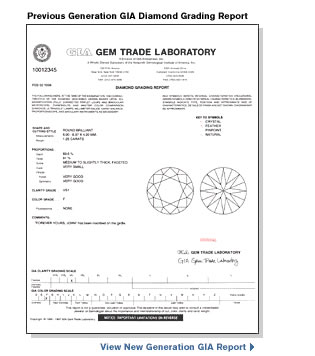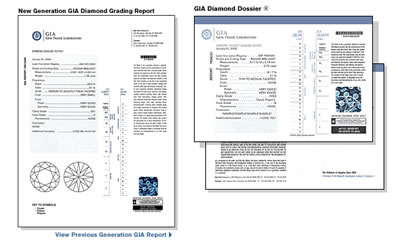An original GIA diamond grading report will have the Gemological Institute of America logo in the upper left. GIA GEM TRADE LABORATORY will be at the top of the document, with addresses and phone numbers, and the document will be laminated. The report will have a number. The position of this number will vary depending on the date issued. Recent documents have the number in the upper left hand corner under the GIA logo. Below that number will be the date of the document. Other places in which the report number will appear will often be to the right of the centered "DIAMOND GRADING REPORT" just below the addresses and the phone numbers of the lab.
Phony GIA certificates are known but they are quite rare and unusual. Very old certificates may have an LA or NY in front of the number. This indicates whether the document was created in the Los Angeles office or the New York office.

As an example of what you can expect to see on the old format certificate, the following sample GIA certification is illustrated.
GIA Certifications - Two Styles

The GIA currently has two styles of certifications, the Diamond Grading Report and the Diamond Dossier. Each certificate has a unique identification number that can be linked back to the grading laboratory's database.
Shape and Cutting Style details the style of cut for the diamond. There are many shapes including the Emerald and a variety of Brilliant Cuts (Round, Oval, Pear, Heart and Marquise). Many popular shapes are patented names and are not used on GIA certifications. For example, the Princess is described as a square modified brilliant, the Radiant is described as a rectangular cut-cornered modified brilliant and the Asscher is a square emerald.
Measurements are provided in millimeters to the hundredth of a millimeter and include length, width and depth. These measurements are taken with a millimeter gauge especially designed for measuring gems and jewelry. This information can be extremely helpful in protecting yourself from having your diamond "switched" in the future. It is very unlikely that anyone could find another diamond with the same three dimensions expressed to the hundredth of a millimeter.
Weight of a diamond is expressed in carats. A diamond scale is use to measure the weight of diamonds and is accurate to 0.01 carats.
Proportions describe various parts of the diamond in relation to other parts of the diamond. The Depth % is the ratio of depth to the average diameter. The table % is the ratio of the flat top (table) compared to the diameter. The girdle is the thin rim that separates the crown of the stone from the pavilion and is described in words that range from thin to extremely thick. The finish of the girdle (unpolished or faceted) will also be described. The Culet is the little facet at the very bottom of the stone and can range from large to non-existent. Large culets are generally considered unacceptable.
Finish indicates the grade of polish and symmetry of the stone. The symmetry describes how well the facets in the crown are aligned with the facets in the pavilion. For both polish and symmetry, it is desirable to be good, very good, or excellent.
Clarity Grade will be listed using the GIA grading scale. Only one clarity grade will be identified. If you see specifications for a diamond that have a range of clarity grades (VS2-SI1) or do not have the number in the grade (VS or SI), you know the diamond does not have a certification and the grades are suspect.
Color Grade will be listed using the GIA grading scale. Only one color grade will be identified. If you see specifications for a diamond that have a range of color grades (G-H), you know the diamond does not have a certification and the grades are suspect.
Fluorescence is a description of how ultraviolet light affects the diamond. About 50% of gem diamonds are fluorescent with about 35% having a level that impacts the appearance. Most fluorescence is blue, but other colors such as yellow, orange and green can appear. While no fluorescence is generally preferred, faint fluorescence can sometimes be a positive feature provided it isn't so strong that it makes the diamond look cloudy.
Comments are provided for those features of a diamond that a laboratory wants you to know but do not fit in the other specific categories. Most comments are minor and do not impact the value of the stone.
Plot of the diamond is the diagram of the internal inclusions and external blemishes as viewed with 10X magnification. The marks on the plot identify the location, size and type of flaws and very useful in the identification of your diamond. The plot becomes the fingerprint of the diamond and can be used to match the stone to the certification.
Source:www.diamondsourceva.com
No comments:
Post a Comment